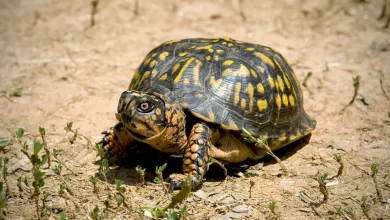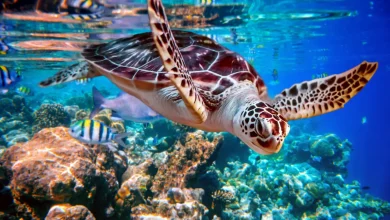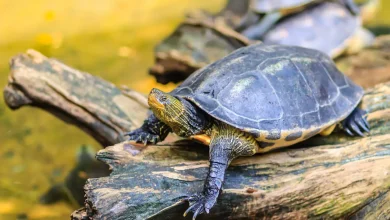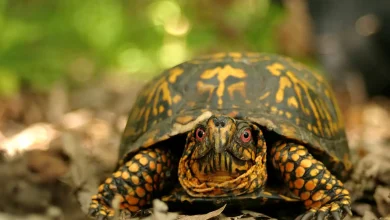Florida Box Turtle (Terrapene carolina bauri)
The Florida Box Turtle is a subspecies of the common box turtle belonging to the Emydidae family.
Terrapene carolina bauri (Taylor, 1895)
Table of Contents
Florida Box Turtle Distribution
As its name implies – the Florida box turtle is found mainly in Florida and the Keys. It does sometimes wander as far north as southern Georgia.
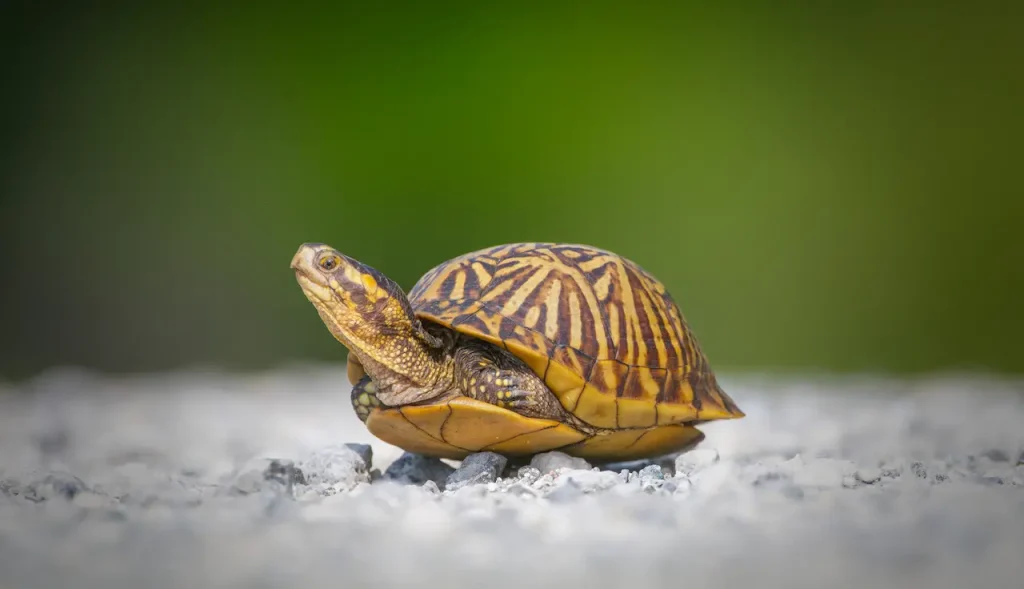
Florida Box Turtle Habitat
The Florida box turtle is usually found in marshes, swamps or forests in areas of high humidity. Though it loves to lie in the water it rarely swims.
Unlike other box turtles, the Florida box turtle usually slows down during the winter months but does not hibernate. This is probably due to the warmer climate in which it lives.
Body
The average size of the Florida box turtle is 4 to 6 inches. It has a highly domed shell with a hinge so it can completely enclose its body within its shell.
The Florida box turtle is similar in colour to the Western Ornate turtle but has thinner and more numerous yellow markings. The background of the shell is black. It has thick yellow stripes on each side of its head. The back of its shell flares out slightly.
The Florida box turtle has very sharp claws and is a good climber. They normally have four toes on their back feet.
Sexing a Florida Box Turtle
A male Florida box turtle usually has bright red or orange eyes. The male’s tail is usually longer and thicker than the female’s. The male also has a hooked claw on its back feet.
The female has dark red or brown eyes. The female’s plastron is usually flatter than the male’s.
What Does a Florida Box Turtle Eat?
The Florida box turtle eats a large variety of insects such as slugs, earthworms, beetles, crickets, flies, and spiders. This makes up about 60% of their diet.
They will also eat berries, moss, and mushrooms.
How old can a Florida Box Turtle get?
The Florida box turtle can live for as long as fifty years or more with the proper diet and care.
Keeping Florida Box Turtles as pets
Currently, it is against the law to own more than two of these species in the state of Florida without a permit. It’s always a good idea to check local laws in your own area.
A Florida box turtle requires a long-term commitment from its owner. Like most box turtles; they can live much longer than a cat or dog. Be sure you’re prepared to take on the responsibility for their care.
They make good pets because they are small and do not bite. They are interesting to watch and observe. However, they do enjoy being handled and do not require companions. It is a good idea to handle them periodically to check for possible health issues.
Never take a Florida box turtle from the wild. Not only is it illegal but It is hard for a turtle that grew up in the wild to adapt to living in captivity. Many do not survive being taken from captivity and made into pets.
You may be able to adopt one from the humane society.
Another option is to find breeders who raise turtles to sell. It’s always best to purchase captive-bred turtles.
Florida box turtles can also be found in pet stores and online.
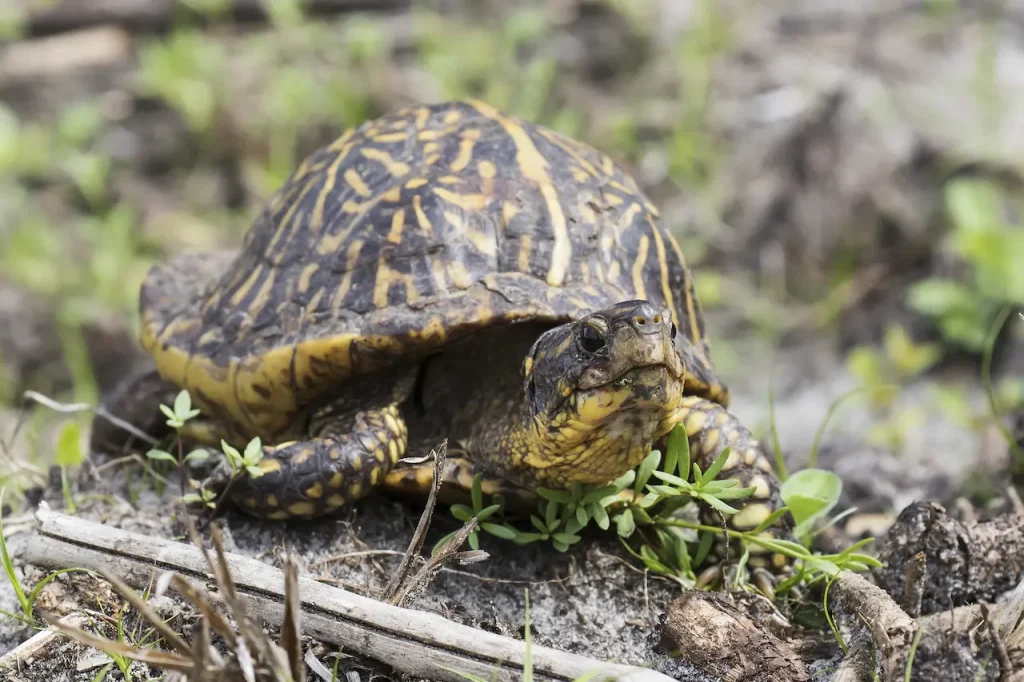
Housing a Florida Box Turtle
A Florida box turtle can be kept in an outdoor or indoor enclosure. Outside is best because it usually gives the turtle more room to roam and a more stimulating environment.
The Florida box turtle likes to spend a lot of time in the water so be sure there is a bowl of water available that it can climb in and out of easily.
The enclosure should receive some direct sunlight but also have plenty of plants for shade. High humidity is required for this turtle so you’ll need to spray once a day during the warmest months.
Because the Florida box turtle has extremely sharp claws it is an excellent climber. You need to remember this when you build its enclosure and be sure the sides are not made of some type of fencing that will be easy for your turtle to climb.
Because turtles are expert diggers your enclosure needs to go under the ground 10 to 12 inches using bricks or some sort of fencing.
If you decide to house your Florida box turtle indoors it’s best to use a large Rubbermaid tub. A substrate of 6 or 7 inches should be sufficient. Use pea gravel on the bottom and a layer of moss and sand on the top. Add plants such as English ivy.
There should be a shallow bowl or tub large enough for the turtle to lie in but not deep enough for swimming.
A UVB bulb should be used to provide heat for an inside enclosure. A large flat rock or slab of slate allows the turtle to “sun” itself under the bulb.
Glass enclosures are not recommended for Florida box turtles. If you do choose to use glass it’s best to cover the outside with paper so the turtle will not be stressed by outside movements or make repeated attempts to walk through the glass.
It’s always a good idea to keep new pets quarantined from your current turtles until you’re sure they don’t carry a viral or bacterial infection. Consider taking them to a vet for a check-up before placing them in with your current pet turtles.
Remember: when using an outdoor enclosure it must be secured against predators such as dogs.
Feeding a Florida Box Turtle
Florida turtles eat many types of live food including snails, earthworms, wax worms, beetles and even baby mice.
They will also eat berries, dark leafy vegetables, mushrooms and cantaloupe a few times a week.
Parasites
It’s important to periodically check your Florida box turtle for any signs of parasites. Like most box turtles; if they are bred in captivity and kept indoors they will probably remain free from parasites. A wild-caught turtle should be examined by a vet to ensure that is healthy and free from parasites such as larvae and parasitic flies.
References
- Holotype: Taylor, W. E. 1895. The box tortoises of North America. Proc. U. S. Nat. Mus. 573-588
- Iverson, J. B. 1992. A Revised Checklist with Distribution Maps of the Turtles of the World
- Ernst, C. H., Wilgenbusch J. C., Boucher T. P., & Sekscienski S. W. (1998). Growth, allometry and sexual dimorphism in the Florida box turtle, Terrapene carolina bauri. HERPETOLOGICAL JOURNAL. 8, 72-78.
- Dodd, J.. C. K. (1997). 1997&. Clutch size and frequency in Florida box turtles (Terrapene Carolina bauri): implications for conservation.. Chelonian Conservation and Biology. 2, 370-37
